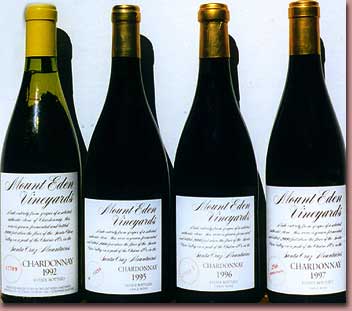|
It was a beautiful sunny day and, as Glenda and I drove into the Santa Cruz Mountains from Los Gatos, then up the unpaved roads toward the peak of Mount Eden, the spectacular vistas spread in the distance below the mountain vineyards. Harvest was just getting under way. As we pulled into the
Mount Eden property, we spotted a man atop one of the stainless steel fermentation tanks. He called to us in greeting as we got out of our car, and we joined him on the platform.
Jeff Patterson introduced himself and I peered down into the tank, watching him work as we talked. He was gently punching down the cap of the red grapes in the tank by hand. This is quite different from the approach used in the high-volume mechanized wineries, which use hydraulic-driven plates to punch down the cap. The heady aroma of harvest was in the air.
I turned to look out over the south Bay Area in the distance below. The
Patterson's home and winery is here at the top
- over 2,000 feet above the valley. Immediately at my feet lay vineyards that had been first planted back in the 1940s by
Martin Ray.
 Jeff led us to the terrace of his home, which was all of 10 yards away, and we sat in rockers looking out over the vineyards, with
Sky the dog providing company. As we talked, Jeff uncorked a
1996 Estate Chardonnay. He has about 18 acres of chardonnay planted outside his door, on the top of Mount Eden. At 2,000 feet, in this arid environment, the vineyards are dry-farmed, producing about 1 to 2 tons of fruit per acre, depending on the year. The first chardonnay rootstock on Mount Eden was brought back from Burgundy by the elder
Paul Masson. And fine fruit it is. Jeff led us to the terrace of his home, which was all of 10 yards away, and we sat in rockers looking out over the vineyards, with
Sky the dog providing company. As we talked, Jeff uncorked a
1996 Estate Chardonnay. He has about 18 acres of chardonnay planted outside his door, on the top of Mount Eden. At 2,000 feet, in this arid environment, the vineyards are dry-farmed, producing about 1 to 2 tons of fruit per acre, depending on the year. The first chardonnay rootstock on Mount Eden was brought back from Burgundy by the elder
Paul Masson. And fine fruit it is.
 The Mount Eden Estate Chardonnay exemplifies classic California chardonnay at its very best. By classic, in this context,
I'm referring to the style of the wine. Jeff makes chardonnay the old-fashioned way: 2 to 3 months sur lees, 50% to 100% new French oak (depending on the size of the crop), light filtration, bottling after 6 months. But where most California winemaking pushes this to the extreme, resulting in bottles of big, fat, butter and oak juice, Jeff is guided by a sense of balance and elegance. And where most California winemaking in this style is aimed at trying to create something of interest out of mediocre to poor fruit, Jeff has no such deficits to address; he is simply complementing the fruit. The result, for anyone who has had properly aged Mount Eden Estate Chardonnay, is a wine of balance, beauty and elegance. Even those who claim to want only pure, simple fruit juice enjoy this wine, which is a far cry from the overripe,
over-oaked butter-bombs of Napa valley.
The Mount Eden Estate Chardonnay exemplifies classic California chardonnay at its very best. By classic, in this context,
I'm referring to the style of the wine. Jeff makes chardonnay the old-fashioned way: 2 to 3 months sur lees, 50% to 100% new French oak (depending on the size of the crop), light filtration, bottling after 6 months. But where most California winemaking pushes this to the extreme, resulting in bottles of big, fat, butter and oak juice, Jeff is guided by a sense of balance and elegance. And where most California winemaking in this style is aimed at trying to create something of interest out of mediocre to poor fruit, Jeff has no such deficits to address; he is simply complementing the fruit. The result, for anyone who has had properly aged Mount Eden Estate Chardonnay, is a wine of balance, beauty and elegance. Even those who claim to want only pure, simple fruit juice enjoy this wine, which is a far cry from the overripe,
over-oaked butter-bombs of Napa valley.
There are those who argue that wines that undergo full-malolactic cannot age. Mount Eden Estate Chardonnay puts that notion to rest. This chard is noted for its
age worthiness. In fact, it should never be drunk too young. Jeff recommends 3 years before the wine begins to see its potential, often peaking at around 5 years, and holding for 3-5 more years at peak. Jeff contends that the secret to the ageability of chardonnay is the quality of the fruit. As to what characteristics comprise quality, my personal take on the subject is that it involves an assortment of factors that include the balance of natural acidity with natural sweetness and the growing conditions.
Jeff broke away to take a cell-phone call regarding a piece of equipment. Harvest was under way. I felt a sense of guilt that we were keeping him from his work, at the most important time of year. And yet, he sat back down and uncorked the
1997 old vines Pinot Noir, and we
continued our conversation.
 Next page
Next page
 Link
to Gang of Pour Home Page Link
to Gang of Pour Home Page
 Link
to Gang of Pour Site Index (Table of Contents) Link
to Gang of Pour Site Index (Table of Contents)
October, 2000 © David King


|